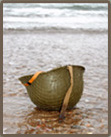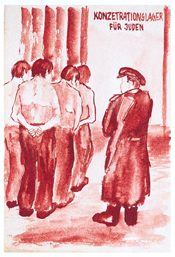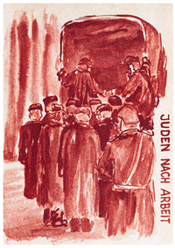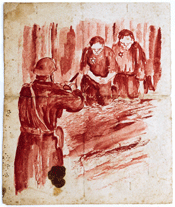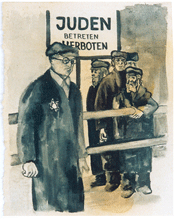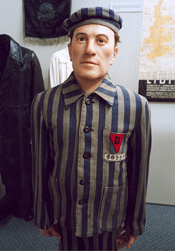 |
Both the victims and the Nazis are represented in letters and photographs, from Anne Frank and Raoul Wallenberg to Heinrich Himmler, Adolf Eichmann and Joseph Mengele. Wall posters restricting and condemning Jews and others, and uniforms of concentration camp guards and inmates from Buchenwald, Dachau and Auschwitz are mixed with many examples of the Nazi's racial policies and use of slave labor.
Inmate's Concentration Camp uniform, worn by Francois Scheaken, a Belgian prisoner and survivor of Buchenwald, exhibited with his displaced person's papers from his liberation in 1945. |
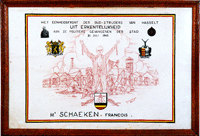 |
| Drawing presented to Scheaken by his hometown. |
|
| |
| SS Officer at Dachau |
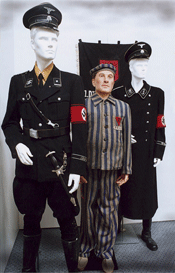 |
Concentration Camp uniform, worn by Josef Wolski, a prisoner in Auschwitz, Mauthausen and Buchenwald. |
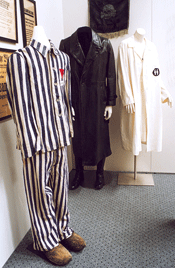 |
|
| |
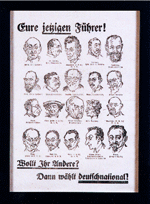 |
Early Anti-Semitic Poster: "Choose Your Fuhrer! ....Do you want another? Then vote Deutsch National!" |
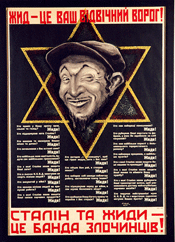 |
|
| |
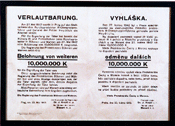 |
Anti-Semitic directives. |
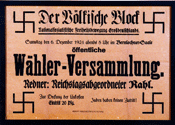 |
|
| |
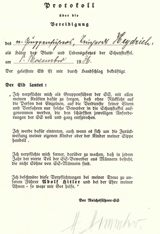 |
Heinrich Himmler, document signed, November 8, 1936: “Record of the Oath of SS Group Leader Reinhardt Heydrich, as protector of the law of blood and life of the Protective Troop Schutzstaffel [SS]. As Group Leader of the SS, I pledge to see to it with all my strength that only such applicants be admitted to the Schutzsaffel, regardless of the person of the individual [or] the achievements of his parents and ancestors, who completely correspond to the most severe demands the SS may make. I will advocate this even if it means rejecting my own children or the children of my relatives. Furthermore, I pledge to see to it that each year a quarter of the SS applicants are made up of men who are not the sons of SS men. I swear to these pledges on my loyalty to our Führer Adolf Hitler and on the honor of my ancestors, so help me God.” |
|
| |
 |
Signs found mounted together in the town of Albertshof, south of Würzburg.
“Our greeting is Heil Hitler!”
“Jews are not allowed here” |
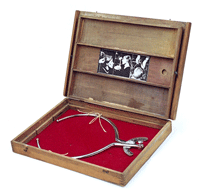 |
Calipers used to measure head sizes, to determine "Perfect Aryans" |
|
| |
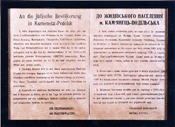 |
Poster stating that Jews are required to go to a ghetto. |
 |
Poster stating Jews are not to be given shelter. |
|
| |
Watercolors of the Warsaw Ghetto
|
| |
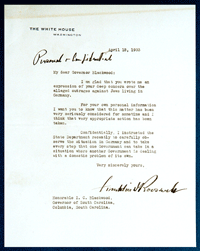 |
Letter from President Franklin D. Roosevelt to I.C. Blackwood, addressing Blackwood's concerns about rumors of problems in Germany involving Jews. |
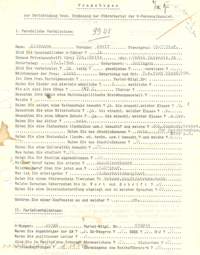 |
Adolf Eichmann. Questionnaire filled out and signed by him, November 25, 1937. |
|
| |
| Work pass issued to a Jew assigned to a slave labor camp in Krakow, accompanied by his ration card for heavy labor workers. He did not survive. |
 |
|
| |
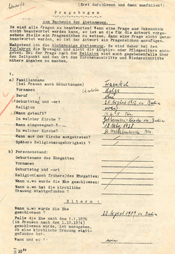 |
Letters to Helga Franklin, concerning her unsuccessful attempt to get permission to marry the father of her children, Gerhard Haupt. Her father’s parents were Jewish, her mothers Christian, and according to the Nuremberg Laws sent to her, illustrated here, she was a first grade half-breed who could only marry with special permission. The lengthy questionnaire explains her history. The request was denied. |
|
| |
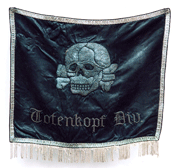 |
Flag of the "Death's Head" division of the SS |
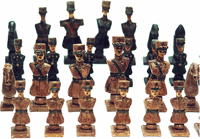 < < |
Chess set, made from rye bread by a prisoner at Auschwitz concentration camp for an SS guard. The King piece on the brown German side was crafted to resemble Hitler. |
|
| |
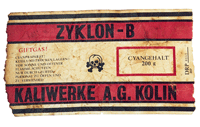 |
The label from a canister of Zyklon-B, the lethal gas used in concentration camp gas chambers. |
|
| |
| Various torture devices used by the Nazis. |
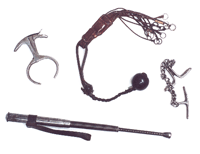 |
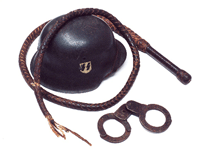 |
|
| |
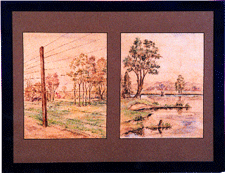 |
Painting by concentration camp inmate Lutz Lamb |
|
| |
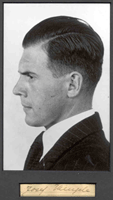 |
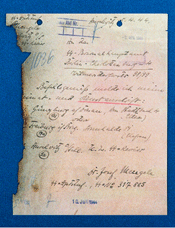 |
Dr. Josef Mengele, autograph manuscript, signed Auschwitz, April 5, 1944. Sent to the SS personnel office in Berlin and gives Mengele's parents' home and office addresses. |
|
| |
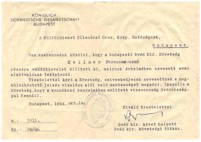 |
Raoul Wallenberg.. Typewritten letter signed, October 10, 1944. A protective passport to save a Jew from the Nazis. Wallenberg was a Swedish businessman and diplomat who became a legendary figure through his efforts to rescue Hungarian Jews during the war and through his disappearance while a prisoner in the Soviet Union. "We have the privilege of informing you that the Swedish Royal Embassy in Budapest has issued to Mrs. Kellner, Ferenc-né a protective passport, according to which the person named above is to be considered a Swedish subject. Our Embassy respectfully requests that you exempt the person named above from bearing the distinctive sign. The Embassy certifies that the reciprocity mentioned in the pursuant decree is in full effect with Sweden." |
|
| |
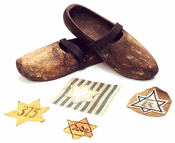 |
Artifacts of inmates of the Concentration Camps. |
|
| |
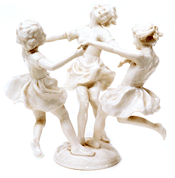 |
Statues made at the SS Allach porcelain factory by prisoners of the Dachau concentration camp.The SS employed inmates exclusively to produce porcelain statues, ornaments, spoons and candlestick holders. |
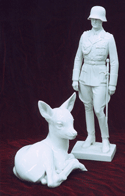 |
|
| |
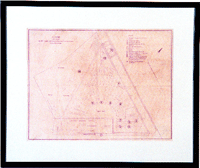 |
German map of the layout of Sachsenhausen concentration camp. |
|
| |
ANNE FRANK
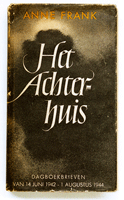 |
First edition of The Diary of Anne Frank |
|
| |
| Anne Frank's father, Otto Frank, October 14, 1947: “Anne’s book is very successful here, and in November the second edition will come out. I enclose some reviews which you could maybe send to Emmchen. More and more of them continue to appear. On the radio they have read from the book 4 times. I hope I can succeed in having English and German editions published.” |
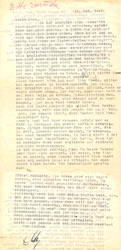 |
|
| |
 |
Alice Frank, Anne’s paternal grandmother, letter, September, 1945: “Margot and Anne were taken to Belsen, as they were too weak to work. Margot got typhus and died and Anne who knew her mother was dead and felt sure her father must be dead also, just faded away.” |
|
| |
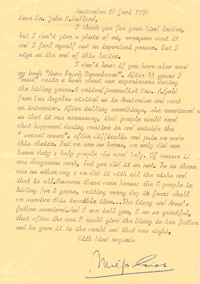 |
Miep Gies,. Dutch woman who hid Otto Frank and his family in her attic. She later discovered Anne Frank’s diary after the family had been arrested and hoped to return it to her after the war: . Letter, June 18, 1990: "...We are no heroes, we only did our human duty: help people who need help. Of course it was dangerous work, but you did it..." |
|

